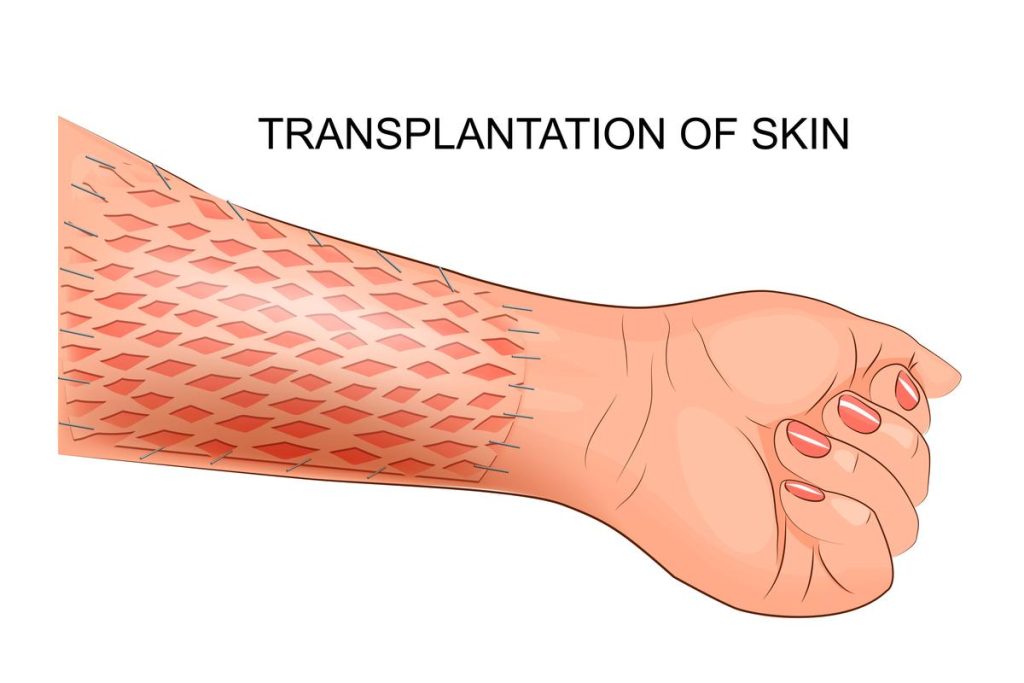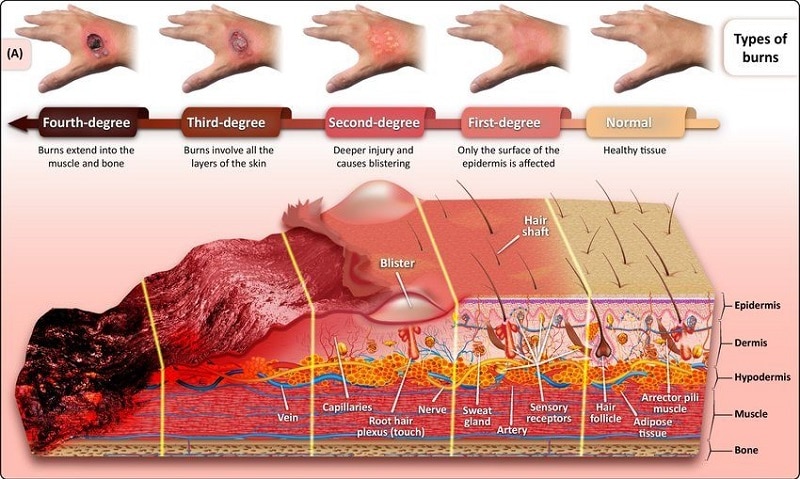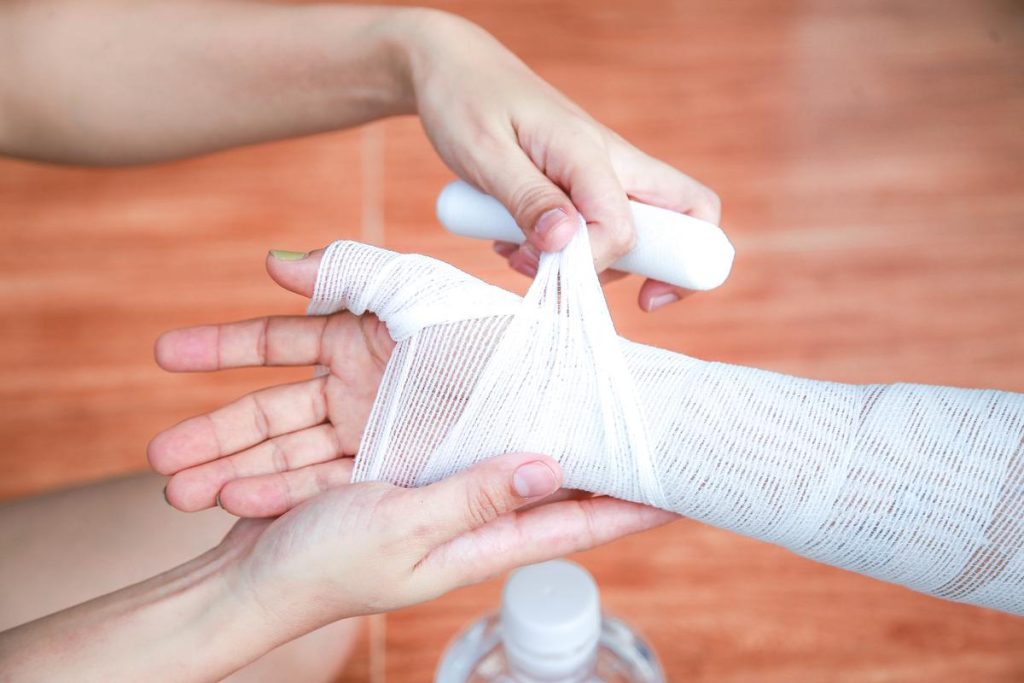Skin Graft
Skin grafting is a surgical procedure where doctors remove healthy skin from one area of the body and implant it into another area.
This is done in order to replace or cover skin that has been damaged or is missing. Skin damage or loss can occur due to burns, injuries, disease, or infection. Doctors may suggest a skin graft as a follow-up to surgery for removing skin cancer.

What is a skin graft?
Typically, this procedure is carried out when you are under the effects of general anesthesia, ensuring that you are in a state of unconsciousness and free from any discomfort.
The donor site is where healthy skin is extracted from your body. Typically, individuals undergoing a skin graft receive a split-thickness skin graft, which involves harvesting the top two layers of skin (the epidermis) and the layer beneath it (the dermis) from the donor site.
The area from which the donor is selected can be located on any part of the body. Typically, it is a region that is not easily visible when covered with clothing, such as the buttock or inner thigh.
The covering graft is applied with caution to the exposed region where it will be relocated. It is secured in position either by soft pressure from a padded dressing that completely covers it, or by using staples or a small number of stitches. The area where the tissue is taken from is also covered with a clean dressing for a period of 3 to 5 days.
Individuals who have experienced greater tissue loss may require a complete skin graft, which involves obtaining the entire thickness of skin from the donor area instead of solely the outermost layers.
A full-thickness skin graft is a more complex surgery. Typical areas where skin is taken for this type of graft are the chest wall, neck, back, or abdominal wall.
Why are skin grafts done?
A skin graft is used to cover a part of the body that has lost its skin. It is usually done in cases when the skin is lost due to various reasons.
- Infection
- Burns
- Venous (varicose) ulcers
- Pressure ulcers (bedsores)
- Diabetic ulcers
- A surgical procedure is performed to eliminate cancer, such as skin or breast cancer.
- Contracture refers to when the skin becomes excessively tight during the healing process, leading to a restriction in joint mobility.
- Nipple and areola reconstruction
- Vitiligo refers to the condition where patches of the skin lose their natural color.
- Trauma

Types of skin grafts
There are two fundamental kinds of skin grafts: grafts that involve only a portion of the skin’s thickness, called split-thickness grafts, and grafts that involve the entire thickness of the skin, known as full-thickness grafts.
Split-thickness grafts
A split-thickness graft consists of removing both the outermost layer of the skin, known as the epidermis, and a portion of the underlying layer called the dermis.
The surgeon takes off these layers from the donor location, which is where the healthy skin is found. Split-thickness skin grafts are commonly taken from the front or outer part of the thigh, abdomen, buttocks, or back.
Split-thickness grafts are utilized by surgeons to provide coverage for extensive areas of injured skin.
These transplants are often delicate and usually have a glossy or sleek texture. They may also appear lighter in color compared to the surrounding skin.
Children who undergo split-thickness grafts may require further grafts in the future as their skin’s growth is not as efficient as that of ungrafted skin.
Full-thickness grafts
In a full-thickness graft, surgeons remove both the top layer of skin (epidermis) and the underlying layer (dermis) from the donor site. Typically, they choose to take healthy skin from areas such as the abdomen, groin, forearm, or above the collarbone.
Typically, the surgeon closes the donor site using stitches or staples in a straight-line incision, resulting in smaller pieces of skin known as grafts.
In order to effectively treat small wounds on visible areas like the face, doctors frequently utilize full-thickness grafts. Unlike split-thickness grafts, these types of grafts seamlessly integrate with the surrounding skin, resulting in a more favorable cosmetic result.
Composite graft
In this process, doctors move skin and other soft tissues like cartilage to repair injuries to body parts such as the nose, fingertips, and ears. Composite grafts are used for this purpose.
What to Expect on the Day of Surgery
Before Surgery
Your healthcare provider may schedule your skin graft surgery a few weeks before it takes place. They may ask you to discontinue certain medications, like aspirin, Coumadin, or Jantoven (warfarin), as these can disrupt the blood from clotting properly. It is important to inform your healthcare provider beforehand about any prescription or over-the-counter medications you are currently using.
What happens during skin graft surgery?
In a hospital setting, you will undergo skin graft surgery. Typically, this surgery is performed while you are fully asleep under general anesthesia, although smaller grafts can be done with local anesthesia. The surgeon will make cuts and extract healthy skin from the donor site. The specific technique employed by your healthcare provider will determine where the healthy skin is taken from.
- Abdomen (belly).
- Back or chest.
- Bottom or groin area.
- Clavicle area (collarbone).
- Forearm.
- Inner thigh, outer thigh or hip.
Prior to transplanting the unblemished skin, your healthcare provider may puncture it with small holes or create multiple minuscule intersecting incisions, a practice known as meshing. This results in the healthy skin resembling a fishnet. This method enables your provider to expand the coverage area of the skin graft and aids in the post-surgical healing process of the affected area.
The medical professional will cover the damaged or absent skin with healthy skin and fix it in position using stitches or staples. They will then apply a dressing over the area. Both the area where the healthy skin was taken from (donor site) and the area where it was placed (graft site) will recover after the surgery. However, it is likely that the graft site will take longer to heal.

After the Procedure
Recovering after split-thickness skin grafting should be speedy, while full-thickness grafts require a lengthier recuperation period. If you have undergone a full-thickness graft, it may be necessary for you to remain in the hospital during your recovery.
Once you are released from the hospital, make sure to adhere to the provided guidelines on how to properly take care of your skin graft.
- Please consult your healthcare provider on how to properly care for the dressing, including ensuring it does not come into contact with water, as it should be worn for 1 to 2 weeks.
- For a period of 3 to 4 weeks, it is crucial to safeguard the graft from any harm or damage. This involves preventing any impact or engaging in activities that can cause injury or loosen the graft.
- Receiving physical therapy is advised by your surgeon.
Recovery
The time it takes to recover from a skin graft surgery will differ based on the complexity of the procedure. If a split-thickness graft is performed, the healing process may only take a few days. On the other hand, healing from a full-thickness graft will take longer and might necessitate staying in the hospital for one or two weeks.
The normal healing time for the donor site ranges from a few days to a week. Your healthcare provider will probably prescribe pain medication to reduce any discomfort.
In an allogeneic transplant, patients receive immunosuppressive medications to prevent their body from rejecting the skin they received. These drugs lower their immune system’s activity, making them susceptible to infections and potentially harmful to other organs like the kidneys.
Once you leave the hospital, you will be required to wear a bandage for a period of one to two weeks. It is important to consult your healthcare provider on the proper way to maintain and shield the dressing from moisture. Additionally, you should ensure the graft is safeguarded from potential harm for a duration of three to four weeks. This involves avoiding any activities or exercises that could potentially injure or strain the graft, as well as preventing any impacts to the affected areas.
If your surgeon notices that your graft is causing limitations in the full movement of a limb or joint, they might advise undergoing physical therapy.
Treatment in Türkiye:
The medical staff of surgical teams, doctors and consultants in Rehab Türk can provide the best treatment options and free consultations – by striving to keep abreast of the latest medical technologies and methods.

